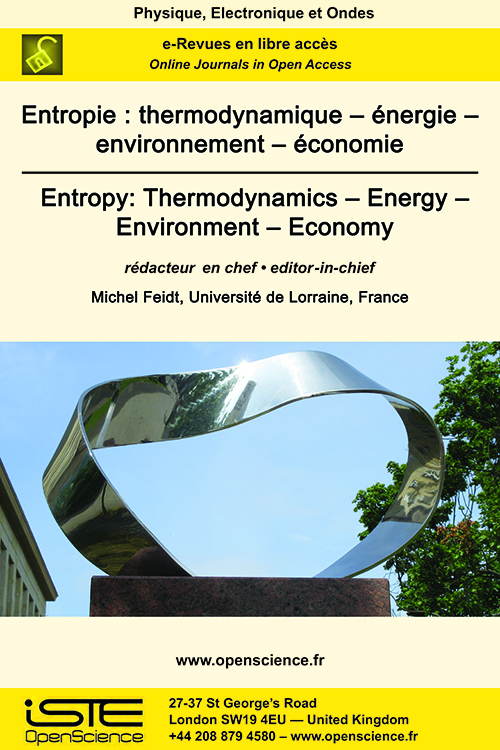

Physics > Home > Entropy: Thermodynamics – Energy – Environment – Economy > Issue
Le projet « Lîla-Entropie», est un projet à vocation heuristique. Sans déroger à la rigueur scientifique qui s’impose, le préfixe « Lîla » qualifie explicitement le présent projet au moyen d’un attribut d’origine Sanscrit indiquant la volonté des contributeurs de cerner, directement ou indirectement, les fondements thermodynamiques de l’évolution du monde, de l’acte créateur qui y prend corps, puis d’en penser le management et le contrôle.
Cet éditorial marque la 3ème année du renouveau du journal ENTROPIE. Celui-ci inaugure une série de numéros spéciaux relatifs à une des notions parmi les plus fondamentales et complexes de la Thermodynamique-Energétique : L’ENTROPIE.
The author returns to the classic definitions of the notion of entropy, the use of which he criticizes in inappropriate situations. Underlying this notion is that of evolution for which various characterizations are proposed.
Different concepts, derived from that of entropy, but which oppose it, will be correlated in the analysis of the living state of matter: those of negentropy and anti-entropy. We will discuss the disruptive role of entropy as well as its contribution to the production of the organization of life (anti-entropy), in space and time. This will allow us to talk about the historicity of the living and to define a space of viability where anti-entropic diversity is obtained by integration/assimilation of local entropy (variation) in the spatial structures and temporal rhythms of the living. The local thus co-constructs the global, while they constitute a constraint of one on the other, in a tension at the heart of phylogenesis and ontogenesis.
This paper is a brief presentation of the so called Non-Extensive Algebra. This algebra is related to the generalization of the exponential and logarithm functions depending on an external parameter. The relationship between these operators & this algebra and fractal geometry & the dynamics under the control of non-integer differential operators is analyzed. The different aspects of the incomplete statistics are developed using the new operators.
The concept of entropy has traveled along winding roads since it was introduced in 1865 by Clausius as a key piece to complete thermodynamics and its Legendre transforms structure. Boltzmann, followed by Gibbs, has then revealed its microscopic interpretation, thus leading to the additive expression $$$S_{BG}=k\sum_{i=1}^W p_i \ln (1/p_i)$$$. A few decades later von Neumann provided its quantum form, and Shannon connected it to the theory of communications. Some time later, in 1961, Rényi generalized the Boltzmann-Gibbs-von Neumann-Shannon form, though preserving its additivity. There was then a real explosion of nonadditive entropic functionals, close to fifty nowadays. Inspired by multifractals, we postulated in 1988 the form $$$S_q\equiv k \sum_{i=1}^W p_i \ln_q (1/p_i)$$$ [with $$$\ln_q z \equiv (z^{1-q}-1)/(1-q);\, \ln_1z=\ln z$$$] as a basis for generalizing the Boltzmann-Gibbs statistical mechanics itself. Along the present brief perspective, we present the foundations and main applications of this theory, currently referred to as nonextensive statistical mechanics.
This paper aims to highlight J.A. Tenreiro Machado’s research on the probabilistic interpretation of the fractional derivative and his definition of entropy recognized in the scientific literature as Machado’s entropy. This presentation is contextualized in his work trajectory in the field of fractional calculus.
Through some mathematical transformations, this paper highlights the internal nature of fractional models described by fractional differential equations or pseudo state space descriptions. In particular, the impulse response computation for considered fractional model using the Cauchy method shows that they exhibit infinitely small and high time constants. The diffusive representation of these models is the deduced. Using Fourier transform a representation of fractional models with a diffusion equation defined on an infinite space domain is then deduced. Fractional models can thus be viewed as doubly infinite dimensional models: a first infinite as they are distributed and a second infinity as they are defined on an infinite domain. This infinite domain or the infinitely large time constants of the impulse response reveal a property intrinsic to fractional models: their infinite memory.

2025
Volume 25- 6
Issue 12024
Volume 24- 5
Special issue LILA 22023
Volume 23- 4
Issue 12022
Volume 22- 3
Issue 12021
Volume 21- 2
Special issue2020
Volume 20- 1
Issue 1